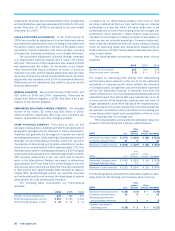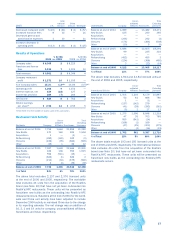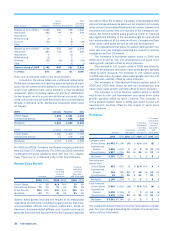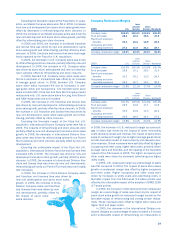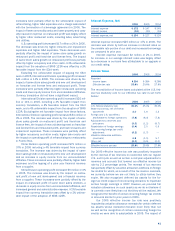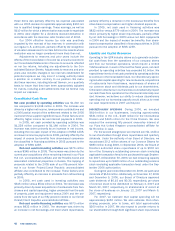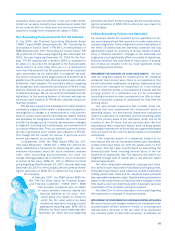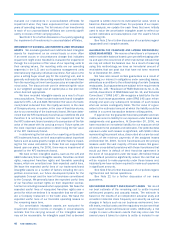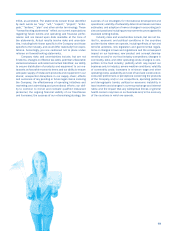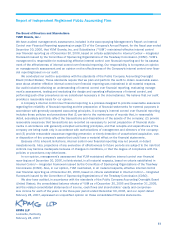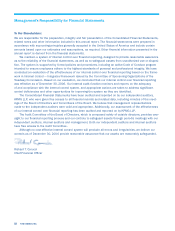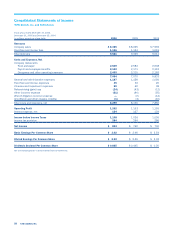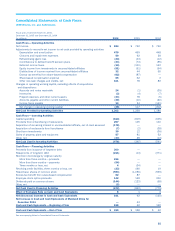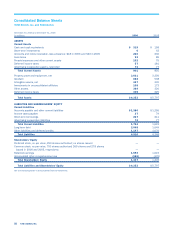Pizza Hut 2006 Annual Report Download - page 41
Download and view the complete annual report
Please find page 41 of the 2006 Pizza Hut annual report below. You can navigate through the pages in the report by either clicking on the pages listed below, or by using the keyword search tool below to find specific information within the annual report.
46 YUM! BRANDS, INC.
evaluate our investments in unconsolidated affiliates for
impairment when they have experienced two consecutive
years of operating losses. The fair values of our investments
in each of our unconsolidated affiliates are currently signifi-
cantly in excess of their carrying values.
See Note 2 for a further discussion of our policy regarding
the impairment of investments in unconsolidated affiliates.
IMPAIRMENT OF GOODWILL AND INDEFINITE-LIVED INTANGIBLE
ASSETS We evaluate goodwill and indefinite-lived intangible
assets for impairment on an annual basis or more often
if an event occurs or circumstances change that indicates
impairment might exist. Goodwill is evaluated for impairment
through the comparison of fair value of our reporting units to
their carrying values. Our reporting units are our operating
segments in the U.S. and our business management units
internationally (typically individual countries). Fair value is the
price a willing buyer would pay for the reporting unit, and is
generally estimated by discounting expected future cash flows
from the reporting unit over twenty years plus an expected ter-
minal value. The discount rate used in determining fair value
is our weighted average cost of capital plus a risk premium
where deemed appropriate.
We have recorded intangible assets as a result of busi-
ness acquisitions. These include trademark/brand intangible
assets for KFC, LJS and A&W. We believe the value of a trade-
mark/brand is derived from the royalty we avoid, in the case
of Company stores, or receive, in the case of franchise stores,
due to our ownership of the trademark/brand. We have deter-
mined that the KFC trademark/brand has an indefinite life and
therefore it is not being amortized. Our impairment test for
the KFC trademark/brand consists of a comparison of the fair
value of the asset with its carrying amount. Future sales are
the most important assumption in determining the fair value
of the KFC trademark/brand.
In determining the fair value of our reporting units and the
KFC trademark/brand, we limit assumptions about important
factors such as sales growth, margin and other factors impact-
ing the fair value calculation to those that are supportable
based upon our plans. For 2006, there was no impairment of
goodwill or the KFC trademark/brand.
We have certain intangible assets, such as the LJS and
A&W trademark/brand intangible assets, franchise contract
rights, reacquired franchise rights and favorable operating
leases, which are amortized over their expected useful lives.
We base the expected useful lives of our trademark/brand
intangible assets on a number of factors including the com-
petitive environment, our future development plans for the
applicable Concept and the level of franchisee commitment
to the Concept. We generally base the expected useful lives
of our franchise contract rights on their respective contrac-
tual terms including renewals when appropriate. We base the
expected useful lives of reacquired franchise rights over a
period for which we believe it is reasonable that we will oper-
ate a Company restaurant in the trade area. We base the
expected useful lives of our favorable operating leases on
the remaining lease term.
Our amortizable intangible assets are evaluated for
impairment whenever events or changes in circumstances
indicate that the carrying amount of the intangible asset
may not be recoverable. An intangible asset that is deemed
impaired is written down to its estimated fair value, which is
based on discounted cash flows. For purposes of our impair-
ment analysis, we update the cash flows that were initially
used to value the amortizable intangible asset to reflect our
current estimates and assumptions over the asset’s future
remaining life.
See Note 2 for a further discussion of our policies regard-
ing goodwill and intangible assets.
ALLOWANCES FOR FRANCHISE AND LICENSE RECEIVABLES/
LEASE GUARANTEES We reserve a franchisee’s or licensee’s
entire receivable balance based upon pre-defined aging crite-
ria and upon the occurrence of other events that indicate that
we may not collect the balance due. As a result of reserving
using this methodology, we have an immaterial amount of
receivables that are past due that have not been reserved
for at December 30, 2006.
We have also issued certain guarantees as a result of
assigning our interest in obligations under operating leases,
primarily as a condition to the refranchising of certain Company
restaurants. Such guarantees are subject to the requirements
of SFAS No. 145, “Rescission of FASB Statements No. 4, 44,
and 64, Amendment of FASB Statement No. 13, and Technical
Corrections” (“SFAS 145”). We recognize a liability for the fair
value of such lease guarantees under SFAS 145 upon refran-
chising and upon any subsequent renewals of such leases
when we remain contingently liable. The fair value of a guar-
antee is the estimated amount at which the liability could be
settled in a current transaction between willing parties.
If payment on the guarantee becomes probable and esti-
mable, we record a liability for our exposure under these lease
assignments and guarantees. At December 30, 2006, we
have recorded an immaterial liability for our exposure which
we consider to be probable and estimable. The potential total
exposure under such leases is significant, with $336 million
representing the present value, discounted at our pre-tax cost
of debt, of the minimum payments of the assigned leases
at December 30, 2006. Current franchisees are the primary
lessees under the vast majority of these leases. We gener-
ally have cross-default provisions with these franchisees that
would put them in default of their franchise agreement in
the event of non-payment under the lease. We believe these
cross-default provisions significantly reduce the risk that we
will be required to make payments under these leases and,
historically, we have not been required to make such payments
in significant amounts.
See Note 2 for a further discussion of our policies regard-
ing franchise and license operations.
See Note 22 for a further discussion of our lease
guarantees.
SELF-INSURED PROPERTY AND CASUALTY LOSSES We record
our best estimate of the remaining cost to settle incurred
self-insured property and casualty losses. The estimate is
based on the results of an independent actuarial study and
considers historical claim frequency and severity as well as
changes in factors such as our business environment, ben-
efit levels, medical costs and the regulatory environment that
could impact overall self-insurance costs. Additionally, a risk
margin to cover unforeseen events that may occur over the
several years it takes for claims to settle is included in our


